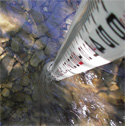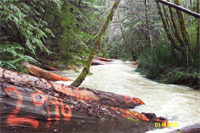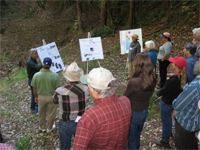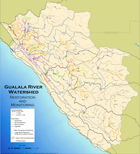GRWC Programs
Cooperative Monitoring Program
Our monitoring program is designed to evaluate long-term trends at the watershed scale and also study restoration effectiveness at the tributary level. Data collected on the physical condition of the watershed allows us to evaluate ecological events, watershed trends, the use of Best Management Practices and the effectiveness of restoration projects.
The GRWC established the Cooperative Monitoring Program in 2000. By 2002, the GRWC had developed a Quality Assurance Project Plan that outlines protocols for watershed-wide monitoring and data analysis. Our plan was one of the first approved for the north coast by the State of California Water Resources Control Board and the North Coast Regional Water Quality Control Board.
 Restoration Program
Restoration Program
The focus of our restoration program is to target the factors limiting salmonid populations in the Gualala.
We do this in two ways; first, we complete upslope sediment work on a planning watershed scale by hydrologically disconnecting all timber and ranch to a level of 95%. This reduces the amount of anthropogenic sediment entering the sub watershed to a level of 20% from 85%. Second, we work instream to recreate the habitat needed by salmonids to spawn and rear in the watershed.
As an example, our Large Wood In the Stream Program restores the natural formation of salmonid habitat by increasing both pool formation and areas of reduced winter flow while providing shelter from predators.
Education and Outreach
The GRWC takes the approach of providing information to the community with the goal of raising critical thought and analysis on issues that affect the watershed.
By freely providing information, all members of the community can draw conclusions on complex scientific, legislative, and regulatory matters. While stakeholders may draw different conclusions from the information presented, the engagement of the community in the process is at core of the GRWC mission.

